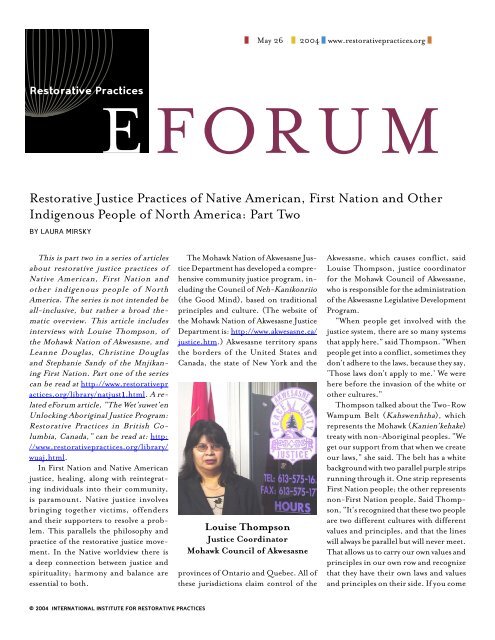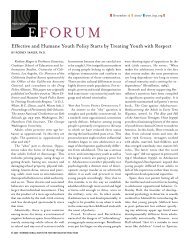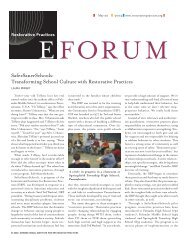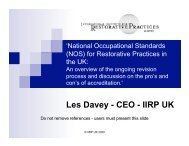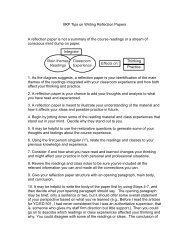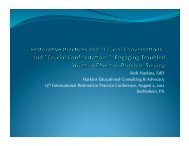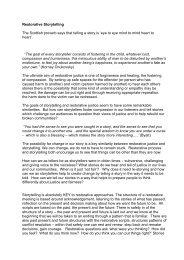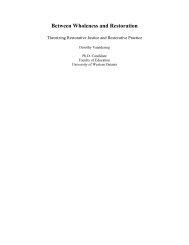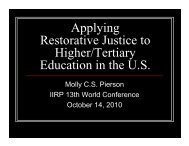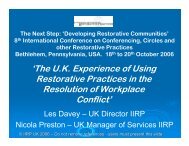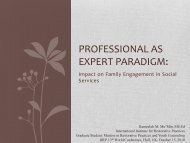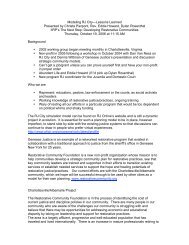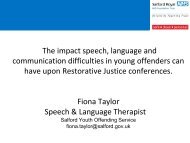Restorative Justice Practices of Native American, First Nation and ...
Restorative Justice Practices of Native American, First Nation and ...
Restorative Justice Practices of Native American, First Nation and ...
Create successful ePaper yourself
Turn your PDF publications into a flip-book with our unique Google optimized e-Paper software.
May 26 2004www.restorativepractices.org<strong>Restorative</strong> <strong>Practices</strong>E FORUM<strong>Restorative</strong> <strong>Justice</strong> <strong>Practices</strong> <strong>of</strong> <strong>Native</strong> <strong>American</strong>, <strong>First</strong> <strong>Nation</strong> <strong>and</strong> OtherIndigenous People <strong>of</strong> North America: Part TwoBY LAURA MIRSKYThis is part two in a series <strong>of</strong> articlesabout restorative justice practices <strong>of</strong><strong>Native</strong> <strong>American</strong>, <strong>First</strong> <strong>Nation</strong> <strong>and</strong>other indigenous people <strong>of</strong> NorthAmerica. The series is not intended beall-inclusive, but rather a broad thematicoverview. This article includesinterviews with Louise Thompson, <strong>of</strong>the Mohawk <strong>Nation</strong> <strong>of</strong> Akwesasne, <strong>and</strong>Leanne Douglas, Christine Douglas<strong>and</strong> Stephanie S<strong>and</strong>y <strong>of</strong> the Mnjikaning<strong>First</strong> <strong>Nation</strong>. Part one <strong>of</strong> the seriescan be read at http://www.restorativepractices.org/library/natjust1.html. A relatedeForum article, “The Wet’suwet’enUnlocking Aboriginal <strong>Justice</strong> Program:<strong>Restorative</strong> <strong>Practices</strong> in British Columbia,Canada,” can be read at: http://www.restorativepractices.org/library/wuaj.html.In <strong>First</strong> <strong>Nation</strong> <strong>and</strong> <strong>Native</strong> <strong>American</strong>justice, healing, along with reintegratingindividuals into their community,is paramount. <strong>Native</strong> justice involvesbringing together victims, <strong>of</strong>fenders<strong>and</strong> their supporters to resolve a problem.This parallels the philosophy <strong>and</strong>practice <strong>of</strong> the restorative justice movement.In the <strong>Native</strong> worldview there isa deep connection between justice <strong>and</strong>spirituality; harmony <strong>and</strong> balance areessential to both.The Mohawk <strong>Nation</strong> <strong>of</strong> Akwesasne <strong>Justice</strong>Department has developed a comprehensivecommunity justice program, includingthe Council <strong>of</strong> Neh-Kanikonriio(the Good Mind), based on traditionalprinciples <strong>and</strong> culture. (The website <strong>of</strong>the Mohawk <strong>Nation</strong> <strong>of</strong> Akwesasne <strong>Justice</strong>Department is: http://www.akwesasne.ca/justice.htm.) Akwesasne territory spansthe borders <strong>of</strong> the United States <strong>and</strong>Canada, the state <strong>of</strong> New York <strong>and</strong> theLouise Thompson<strong>Justice</strong> CoordinatorMohawk Council <strong>of</strong> Akwesasneprovinces <strong>of</strong> Ontario <strong>and</strong> Quebec. All <strong>of</strong>these jurisdictions claim control <strong>of</strong> theAkwesasne, which causes conflict, saidLouise Thompson, justice coordinatorfor the Mohawk Council <strong>of</strong> Akwesasne,who is responsible for the administration<strong>of</strong> the Akwesasne Legislative DevelopmentProgram.“When people get involved with thejustice system, there are so many systemsthat apply here,” said Thompson. “Whenpeople get into a conflict, sometimes theydon’t adhere to the laws, because they say,‘Those laws don’t apply to me.’ We werehere before the invasion <strong>of</strong> the white orother cultures.”Thompson talked about the Two-RowWampum Belt (Kahswenhtha), whichrepresents the Mohawk (Kanien’kehake)treaty with non-Aboriginal peoples. “Weget our support from that when we createour laws,” she said. The belt has a whitebackground with two parallel purple stripsrunning through it. One strip represents<strong>First</strong> <strong>Nation</strong> people; the other representsnon-<strong>First</strong> <strong>Nation</strong> people. Said Thompson,“It’s recognized that these two peopleare two different cultures with differentvalues <strong>and</strong> principles, <strong>and</strong> that the lineswill always be parallel but will never meet.That allows us to carry our own values <strong>and</strong>principles in our own row <strong>and</strong> recognizethat they have their own laws <strong>and</strong> values<strong>and</strong> principles on their side. If you come© 2004 INTERNATIONAL INSTITUTE FOR RESTORATIVE PRACTICES
<strong>Restorative</strong> <strong>Practices</strong>E FORUMinto our territory, our laws apply to you,<strong>and</strong> vice versa. Just like if somebody fromthe U.S. went to France.”Because <strong>of</strong> the Two-Row Wampum, the<strong>Justice</strong> Department <strong>of</strong> Canada recognizesrights <strong>of</strong> <strong>Native</strong> people to create theirown laws, said Thompson. The <strong>Justice</strong>Department <strong>of</strong> Canada developed theAboriginal <strong>Justice</strong> Department, whichprovided $72 million to help the <strong>First</strong><strong>Nation</strong>s create their own justice systems.“Now a lot <strong>of</strong> people are developingtheir own justice programs <strong>and</strong> thegovernment is actually saving money.The federal penitentiaries were crowdedwith <strong>Native</strong> people. Ten years ago it cost$46,000 a year to keep one inmate injail. But when we rehabilitated them itcost nothing, so they gave us money.” Thesame premise applies to probation, saidThompson. “They said, Who would bebetter to supervise these people than thepeople themselves? That’s where we gotthe money to operate our own probation,parole <strong>and</strong> police departments.”“The Indian Act was forced upon us in1898 in Canada, <strong>and</strong> it had all these rules<strong>and</strong> policies on how to conduct yourself.But we don’t force things on people. Ourcustom is to ask the people what theywant to do—to come to a communitycollective agreement.” Accordingly, in1991, the Akwesasne <strong>Justice</strong> Departmentperformed an assessment for the community,asking justice-related questions:“Who should be addressing crimes? Doyou think that the outside courts shouldbe doing this or should we be doing itinternally?” The results <strong>of</strong> the surveywere used by the department to developan administration to address problemsthemselves, including their own laws,their own mechanism to resolve conflicts,<strong>and</strong> their own enforcement <strong>and</strong>rehabilitative processes.In 1994, the department organizedthe Council <strong>of</strong> Neh-Kanikonriio. Itwas decided that whenever there was anMay 26 2004issue, a conflict or a dispute it should goto this council, “the ones who sit withthe people <strong>and</strong> come up with solutions<strong>of</strong> how to make things right <strong>and</strong> restorethe balance <strong>and</strong> harmony within the community,”said Thompson. About 30 men<strong>and</strong> women sit on the council—respectablecitizens <strong>of</strong> the community—elders,middle-aged people <strong>and</strong> a few young“The Indian Act was forcedupon us in 1898 in Canada.But we don’t force things onpeople. Our custom is to askthe people what they want todo—to come to a communitycollective agreement.”—Louise Thompsonpeople. A training seminar teachescouncil members the elements necessaryto conduct a hearing.A panel <strong>of</strong> three or four councilmembers reviews each case. The panel,the victim <strong>and</strong> <strong>of</strong>fender involved in theincident, <strong>and</strong> the resource staff—drug<strong>and</strong> alcohol counselors, child <strong>and</strong> familyservice workers or mental health workers,depending on the circumstances—meetfor a hearing <strong>and</strong> come up with an agreement.The council asks people who cometo them who else they would like to attendthe hearing. “Sometimes people ask to attend,<strong>and</strong> we ask the victims’ <strong>and</strong> <strong>of</strong>fenders’permission,” said Thompson. Thissystem has been in use since 1995, aidedby United States federal <strong>and</strong> Ontarioprovincial government funding.The first thing <strong>of</strong>fenders must do in ahearing is “give respect to Mother Earth,”said Thompson. Often people involvedin criminal activity have totally neglectedthat responsibility, she said. “We bringthese people back down to reality <strong>and</strong>back down to earth, make them realizewww.restorativepractices.orgthat life is so much more meaningful thanhaving money to buy cars <strong>and</strong> clothes.You have to believe that there’s somebodyspiritual over you.”The next step in a hearing is to acknowledgewhy the person has beenbrought before the panel, in a respectfulway, welcoming that person to theoccasion. Then everyone tells the circumstances<strong>of</strong> what happened, <strong>and</strong> eachperson is asked to recommend the bestway to restore the balance <strong>and</strong> harmonyin the situation. A facilitator—a paidjustice-program staff member who coordinatesthe hearing <strong>and</strong> organizes thecircle—takes notes; panel members preparethe document <strong>of</strong> an agreement <strong>and</strong>everybody signs it.The process used in the council isderived from traditional methods, saidThompson. “Back in the 1950s, we hadone person sitting there as justice <strong>of</strong> thepeace, <strong>and</strong> she still brought in the practices<strong>of</strong> the culture, but the manner wasstill very mirrored to the European. Itwasn’t until the 1990s when we decidedthat we didn’t have to practice what theypractice, because we are our own people.That’s the time we put our foot down<strong>and</strong> said, ‘No, we are going to adopt ourtraditional ways—getting everyone together.’”Continued Thompson, “I’m<strong>of</strong> the Wolf Clan, <strong>and</strong> if I did somethingthat would violate the principle <strong>of</strong> theGreat Law [the Kaianerekowa], my clanwould come to me <strong>and</strong> tell me to get backon the right path. It’s those principlesthat we modified to use within the Neh-Kanikonriio Council.”Thompson talked about facilitatinga hearing for “a hard-core personin leather jeans <strong>and</strong> jacket, didn’t giverespect for anybody, had a lengthy record.He was advised by his lawyer togive this a try. [His charge was] assaultwith a weapon. We thought, How are weever going to get through to this guy? Webrought him in, treated him with respect,© 2004 INTERNATIONAL INSTITUTE FOR RESTORATIVE PRACTICES 23⁄4
<strong>Restorative</strong> <strong>Practices</strong>E FORUMMay 26 2004www.restorativepractices.orgreached there, my mother being one <strong>of</strong>the younger children, they cried <strong>and</strong>cried because they didn’t know what theywere being sent there for <strong>and</strong> why, <strong>and</strong>the nuns <strong>and</strong> priests that were runningthis place said, ‘Oh, be quiet. You weresent here <strong>and</strong> you’re going to stay here.Your parents don’t want you no more.Your parents are dead. Your parents arenothing but drunks, <strong>and</strong> you don’t wantto be <strong>Native</strong> people like them—dumb,stupid <strong>and</strong> drunk. You’re going to stayhere with us <strong>and</strong> get an education.’“The majority <strong>of</strong> the time you werein a slave camp. You had to grow crops,tend to animals, run an industrial producecenter, <strong>and</strong> maybe once a week theygave them lessons in school. People diedthere without proper medical attention;people were raped <strong>and</strong> sexually abused,<strong>and</strong> they were punished for speaking theirlanguage. People tried to run away <strong>and</strong>got caught <strong>and</strong> were punished or diedfrom exposure.“Some <strong>of</strong> the survivors have blockedout these traumatic events. And whenthey blocked it out, they also blockedout their culture <strong>and</strong> their language.”Victims <strong>of</strong> the schools come to ask herfor help, said Thompson. “A gentleman70 years old told me that he was sexuallyabused in residential school when hewas seven. I’ve had three or four peoplecome to me like that. With one <strong>of</strong> theseindividuals—I tracked his record—he wasconvicted <strong>of</strong> a sexual abuse <strong>of</strong>fense himself.He learned it.”The Akwesasne have many rehabilitativeservices, including the Men’s WellnessProgram, which includes culturally-basedmen’s wellness camps. “Fora long time we only had programs thatdealt with assistance to women <strong>and</strong> theirneeds,” said Thompson. “We recentlyfound that we were neglecting our men.They need counseling on how to be betterhusb<strong>and</strong>s <strong>and</strong> fathers, or mental healthcounseling. Sometimes they need protectionfrom their wivesin physical abuse.”Akwesasne health<strong>and</strong> social-servicefacilities address thecommunity’s physical,emotional <strong>and</strong> socialneeds <strong>and</strong> providewelfare <strong>and</strong> drug<strong>and</strong>-alcoholservicesfor both adults <strong>and</strong>youth, including aresidence for youthwho are having problemsat home. ConcludedThompson,“You seldom need togo <strong>of</strong>f our territoryfor services.”Another <strong>First</strong> <strong>Nation</strong>community, the Mnjikaning, locatedin Ontario, has developed a communityhealing model <strong>and</strong> restorative justiceprogram. Biidaaban (Ojibwe or Anishinaabefor “new beginning” or “newday”) works with individuals who havecommitted wrongdoing or been hurt bywrongdoing. Biidaaban coordinator LeanneDouglas said that they try to avoid theterms “<strong>of</strong>fender” <strong>and</strong> “victim” so as not tolabel people, but rather address their behavior.“Bii means the future, daa meansthe present <strong>and</strong> ban means the past. We’reincorporating all <strong>of</strong> that: looking at thepast, living in the present <strong>and</strong> lookingtowards the future,” said Douglas.The goal <strong>of</strong> Biidaaban is for peoplewho have harmed to take responsibilityfor the harm they have caused, beaccountable to the community <strong>and</strong> topeople they have hurt, publicly apologize<strong>and</strong> make amends <strong>and</strong> restitution. Workingwith people who have been harmedinvolves trying to help them through theprocess, validating their experience <strong>and</strong>having them be a part <strong>of</strong> the process <strong>of</strong>coming together with the person whohas caused the harm. “We work withMnjikaning <strong>First</strong> <strong>Nation</strong> Social Services StaffBack Row, left to right: Stephanie S<strong>and</strong>y,Lorraine McRae, Leanne Douglas, Byron StilesFront Row: Christine Douglas <strong>and</strong> Susan Lahaytheir families <strong>and</strong> ultimately the wholecommunity,” said Douglas.Biidaaban serves both adults <strong>and</strong>youth. Other Mnjikaning social servicesprograms, all <strong>of</strong> which work closely withBiidaaban, include addictions <strong>and</strong> welfareprograms <strong>and</strong> a child welfare programthat works with the Children’s AidSociety in the town <strong>of</strong> Orillia.The principal problems in the communityare addiction <strong>and</strong> domesticviolence stemming from addiction, saidDouglas. Biidaaban h<strong>and</strong>les cases concerningsuch matters as assault, domesticviolence, breaking <strong>and</strong> entering, sexualabuse, armed robbery <strong>and</strong> impaireddriving, most <strong>of</strong> which involve the courtsystem.“We look at alternative sentencing,such as stays <strong>of</strong> charges, diversions, conditionaldischarges, reduced sentencingor mitigation if they’ve done really well inthe program but it’s been a very seriouscrime,” said Douglas. “We may meet aperson in court <strong>and</strong> tell them about ourprogram; we may have referral by police,by family members, by the individualthemselves.© 2004 INTERNATIONAL INSTITUTE FOR RESTORATIVE PRACTICES 43⁄4
<strong>Restorative</strong> <strong>Practices</strong>E FORUM“In the work with the court systemwe’ve developed an informal protocol,although we’re working on a formal one,where we ask for an adjournment <strong>of</strong> fourmonths, <strong>and</strong> we present an interim treatmentplan at that time. It’s a time for usto assess whether the person is actuallycommitted to a healing process <strong>and</strong> forthe person to see if this is the path theywant to take. The interim treatment planinvolves assessment, therapy <strong>and</strong> counseling<strong>and</strong> is unique to each person.”The healing process consists <strong>of</strong> teamcounseling with the individuals thatare involved—those that have harmed<strong>and</strong> been harmed—in preparation for acircle that includes family <strong>and</strong> the widercommunity. Individuals invite their supportersto the circle, but anyone in thecommunity who wants to participate canattend. “We send a flier to every home inthe community,” said Christine Douglas,clinical manager for Mnjikaning Community<strong>and</strong> Family Services, <strong>of</strong> whichBiidaaban is a component. (Christine<strong>and</strong> Leanne Douglas are not related; theirhusb<strong>and</strong>s are distant cousins.) Attendanceat circles is generally 20 to 25 people.At the community gathering, everyoneintroduces themselves <strong>and</strong> sayswhy they’re there. Next, the people whocommitted the wrong talk about what theydid <strong>and</strong> take responsibility for it. Theneveryone has a chance to talk about whatthe impact <strong>of</strong> the wrongdoing has beenon them. The person then apologizes<strong>and</strong> everyone talks about what needs to bedone to make things right <strong>and</strong> to restoreharmony <strong>and</strong> balance. A communityhealing plan is developed <strong>and</strong> a contractis signed by the person who has harmed<strong>and</strong> the Biidaaban team. The gatheringends with a ceremony. Regular meetingsbetween the Biidaaban team <strong>and</strong> thosewho were involved monitor whether thecontract is being fulfilled. A ceremonialcelebration follows successful completion<strong>of</strong> the Biidaaban process.May 26 2004“When you go to the courtsystem, people in thecommunity really don’t knowwhat’s going on there. Butwhen it’s public <strong>and</strong> in thecommunity then everybodyknows <strong>and</strong> it can act like acommunity watch program.”—Leanne DouglasOut <strong>of</strong> over 80 people who have participatedin the process, only four havere<strong>of</strong>fended <strong>and</strong> only one has committedthe same crime: an assault. The otherthree were recharged with breaches <strong>of</strong>probation due to drinking. “It’s a lotbetter than what the justice system’s statisticsare,” said Leanne Douglas. “Whenyou go to the court system, people in thecommunity really don’t know what’s goingon there. But when it’s public <strong>and</strong> inthe community then everybody knows <strong>and</strong>it can act like a community watch program.So people know that people arewatching them <strong>and</strong> that they need to behaveproperly.” Said Christine Douglas,“Our probation <strong>of</strong>ficer said that whenshe first started to come here, close to thebeginning <strong>of</strong> this program, she had 26probationers. Today she has six.”The court system has received theprogram very well. “We’ve developed awonderful working relationship over thelast several years,” said Leanne Douglas.“It was very difficult at first. It took alot <strong>of</strong> education <strong>and</strong> discussions aboutwhat we were doing, <strong>and</strong> probably inthe beginning they were very reluctant,but I think we’ve proven our credibilityto them. We’ve had cases where peoplehaven’t done very well <strong>and</strong> we’ve turnedthem back to the court system. I thinkdoing that has boosted our credibility,www.restorativepractices.orgbecause they know that we’re not goingto say that people are doing well if they’rereally not. But we always have to do ongoingeducation, because every year a newCrown Attorney [government prosecutor]is appointed.”It took several years to develop theBiidaaban model, said Stephanie S<strong>and</strong>y,Mnjikaning <strong>First</strong> <strong>Nation</strong> social servicesworker. <strong>First</strong>, a core group <strong>of</strong> communitymembers researched their people’s history,then received restorative justice trainingfrom Dr. Ed Connors, a psychologist<strong>of</strong> Mohawk <strong>and</strong> Irish descent. They alsovisited Hollow Water, Manitoba, Canada,which had successfully used healing circlesto cope with a legacy <strong>of</strong> child sexual abuse<strong>and</strong> alcohol addiction. The Mnjikaningdecided to base Biidaaban on HollowWater’s healing model. (To read aboutthe Hollow Water Community HolisticCircle Healing Project, in a paper by one<strong>of</strong> its initiators, Berma Bushie, pleasego to: http://www.iirp.org/library/vt/vt_bushie.html.)The core <strong>of</strong> the Biidaaban model is thesame as Hollow Water’s, said ChristineDouglas, but they adapted it. HollowWater is a small, isolated community innorthern Manitoba, while Mnjikaning,she said, is “very much part <strong>of</strong> southernOntario, which is a very populatedarea.”Since 1996, Mnjikaning has been thesite <strong>of</strong> Casino Rama, one <strong>of</strong> the biggestcasinos in Canada, <strong>and</strong> the largest employer<strong>of</strong> <strong>Native</strong> people in the countryin a single venue. With 12,000 peoplefrequenting it daily, the casino has completelytransformed the community.“Our unemployment rate before thecasino was 65 percent <strong>and</strong> that was aftera lot <strong>of</strong> hard work to get it down to 65percent. Now it’s about 10 percent,” saidChristine Douglas. A l<strong>and</strong> lease <strong>and</strong> directpayments from the casino provide forinfrastructure such as water <strong>and</strong> waste watertreatment <strong>and</strong> police <strong>and</strong> fire fighting© 2004 INTERNATIONAL INSTITUTE FOR RESTORATIVE PRACTICES 53⁄4
<strong>Restorative</strong> <strong>Practices</strong>E FORUMservices. On the other h<strong>and</strong>, gambling hasdefinitely become a problem. The casinoprovides funds for a gambling addictionprogram within the community.Gambling addiction gave rise to asentencing circle attended by over 75community members. Two Mnjikaningcommunity employees were chargedwith the theft <strong>of</strong> over $100,000 <strong>of</strong>the community’s money, stolen due togambling addiction. Leanne Douglas saidshe felt it was an ideal case for the communityto resolve, instead <strong>of</strong> an outsidesystem, “because the community was thevictim; it was their money.” It took alot <strong>of</strong> work <strong>and</strong> negotiation, she said.“We had excellent lawyers who helpedus in this process <strong>of</strong> actually having itcome into our community, <strong>and</strong> we hada judge who was <strong>Native</strong>, so she came herewith the court clerks; it was all set up <strong>and</strong>recorded. We had the Crown Attorney<strong>and</strong> their lawyers.”Community members were glad to haveinput into the process <strong>and</strong> felt that healingresulted. As for the people who hadcommitted the theft, said Douglas, “It wasvery difficult for them. I think they werefrightened about facing the community,but they did have their family supportthere. They took responsibility for whatthey did <strong>and</strong> apologized, but definitely itwas a frightening experience—a lot morefrightening than st<strong>and</strong>ing in court <strong>and</strong>not having to say anything.”The judge took recommendationsfrom the community to determine thesentence, which did not include jail time.“But it was actually probably a toughersentence than what they would have gottenin a court system,” said Douglas.“They’re required to pay back all <strong>of</strong> themoney, which is probably a life sentencein itself. They were under house arrest<strong>and</strong> had three years <strong>of</strong> probation <strong>and</strong>community service hours.” They alsoreceived psychotherapy <strong>and</strong> attended aproblem-gambling program.May 26 2004The Ojibwe medicine wheel, asdepicted in the brochure forBiidaaban, the MnjikaningCommunity Healing ModelChristine Douglas recalled a communityhealing circle, held for a 10-year-oldboy who had fired a pellet gun <strong>and</strong> hitthe back window <strong>of</strong> a taxi going past hishouse. The driver called the police <strong>and</strong>they found the child. It was suggestedthat he attend a community gathering.The cab driver wasn’t able to attend, butthe taxi’s owner came. Said Douglas, “Hetalked about how terrified the taxi driverhad been when it had happened becausehe thought that he was going to be killed;he didn’t know it was just a pellet gun.He talked about the fact that now thecab driver might be afraid to come tothe community. And this child’s motherrelied on cabs because she had no car. Sohe was really able to see the impact <strong>of</strong> hisbehavior. His family was there, <strong>and</strong> wealso were able to talk about all <strong>of</strong> the goodthings that this child is doing. It workedreally well even though the child wasonly 10 years old. And nothing would’vehappened otherwise, because he was tooyoung to charge.”Asked if they felt that the Biidaabanprocess derives from traditional Aboriginaljustice practice, Leanne Douglas saidshe thought it did, “because people tookwww.restorativepractices.orgresponsibility for their behavior <strong>and</strong> itwas the community that tried to set themon the right path. If somebody was actingout <strong>and</strong> not behaving properly, it meantthat they were out <strong>of</strong> balance <strong>and</strong> that theyneeded to be brought back into balance.When we talk about balance <strong>and</strong> harmonywithin the community I think it comesfrom that.” Added Christine Douglas,“It’s a consensus model <strong>and</strong> I think that’svery much an Ojibwe model.”About the tie between justice <strong>and</strong>spirituality, Leanne Douglas said, “Weincorporate spirituality in everythingwe do—in our gatherings, in the workwith individuals. It’s a part <strong>of</strong> ourteachings—using the medicine wheel [a<strong>Native</strong> symbol used in healing <strong>and</strong> otherceremonies] to help the people we workwith underst<strong>and</strong> about their whole self.We look at their spirit, their heart, themind <strong>and</strong> the body, trying to keep that inbalance <strong>and</strong> having them underst<strong>and</strong> thatthey need to work in those four areas.”All healing circles open with a spiritualobservance. “If you’re a traditional personwe open with a smudge [a spiritualpurification using smoke from a burningbundle <strong>of</strong> sage or other sacred herbs] <strong>and</strong>a prayer; if you’re Catholic or Pentecostalor whatever it may be, we do an openingthat’s right for those people. There’sno discrimination about beliefs,” saidDouglas.Asked how the community has acceptedBiidaaban, Christine Douglas said thatpeople in trouble are interested in beingpart <strong>of</strong> the program, “because, atleast initially, they see it as a ‘Get Out<strong>of</strong> Jail Free’ card [as in the board gameMonopoly]. Then they come to realizethat it actually might have been easier togo to jail.”Unfortunately, said Douglas, sometimesthe community also sees the programas an easy way out, because theydon’t really know what it’s about. Fewpeople take part in the program unless© 2004 INTERNATIONAL INSTITUTE FOR RESTORATIVE PRACTICES 63⁄4
<strong>Restorative</strong> <strong>Practices</strong>E FORUMthe situation involves someone closeto them, she explained. She hopes thatcontinuing to educate the communitywill change this. They would like to getmore volunteers involved, especially inthe gatherings.Plans are in process to form a youthjustice circle. “We’re going to personallyinvite some people to be a part <strong>of</strong>that,” said Douglas. “Hopefully whenthey see what we’re doing in the youthjustice circle they’ll be able to underst<strong>and</strong>better what we’re doing with the adults.”Added Leanne Douglas, “We’re going totry to get a cross-section <strong>of</strong> our communityto be a part <strong>of</strong> that, <strong>and</strong> they can talkto their family about it, <strong>and</strong> it can filterdown a little bit.” The ultimate goal <strong>of</strong>Biidaaban, she said is “to have a healthy,safe community, to repair relationships,help people be in balance <strong>and</strong> be healthyin faith <strong>and</strong> happy.”Many articles on <strong>First</strong> <strong>Nation</strong> <strong>and</strong> <strong>Native</strong><strong>American</strong> justice can be found in theIIRP online library, including:“Sentencing Circles for AboriginalOffenders in Canada: Furthering theIdea <strong>of</strong> Aboriginal <strong>Justice</strong> Within aWestern <strong>Justice</strong> Framework,” by MelaniSpiteri. http://www.iirp.org/library/mn02/mn02_spiteri.html.“<strong>Restorative</strong> <strong>Practices</strong> Seen by theCourt,” by the Honorable Judge Jean-L. Dutil. http://www.iirp.org/library/t2000/t2000_jdutil.html.“Circle Sentencing: Part <strong>of</strong> the <strong>Restorative</strong><strong>Justice</strong> Continuum,” by theHonorable Judge Heino Lilles. http://www.iirp.org/library/mn02/mn02_lilles.html.“Aboriginal People <strong>and</strong> <strong>Justice</strong> Issues,”by the Honorable Judge MurraySinclair. http://www.iirp.org/library/t2000/t2000_msinclair.html.The <strong>Restorative</strong> <strong>Practices</strong> eForum willfeature other <strong>First</strong> <strong>Nation</strong>, <strong>Native</strong> <strong>American</strong><strong>and</strong> indigenous justice practices inthe future.May 26 2004www.restorativepractices.org© 2004 INTERNATIONAL INSTITUTE FOR RESTORATIVE PRACTICES 73⁄4


